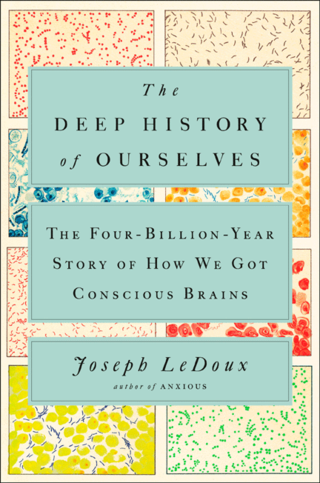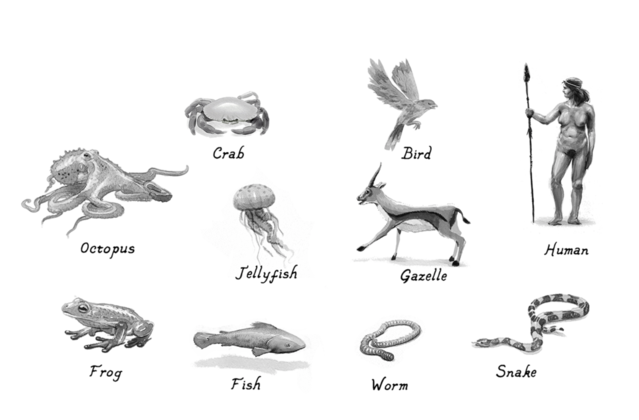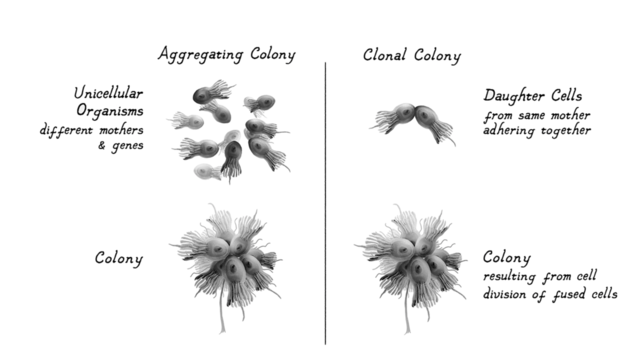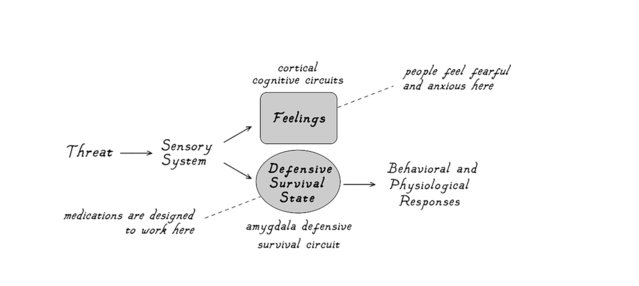Fear
Joseph LeDoux on The Deep History of Ourselves
Why do humans experience fear? How do other organisms respond to danger?
Posted September 16, 2019

In his new book The Deep History of Ourselves: The Four-Billion-Year Story of How We Got Consciousness, renowned neuroscientist Joseph E. LeDoux takes a broad view of the history of life. He examines evolution and zooms in on particular organisms: single-celled protozoa, jellyfish, early amphibians, dogs, humans and other primates. He argues that we will only understand biological history and the behavior or particular species if we examine their distinct physiologies and their "schema"--or bodily knowledge that shape their responses to their environments.
According to LeDoux, we tend to confuse our intuition with scientific fact when it comes to the experience of organisms from protozoa to animals. In LeDoux's words, "we need to be clear about which aspects of human behavior are related to processes inherited from various organisms, so that we can better understanding of those that are not." Science can explain some of these differences, but so far we don't have great methods for discerning consciousness and experience in organisms different from ourselves. But that doesn't stop us from projecting our experience onto them. In this interview, LeDoux explains what we do know. what we can know, and what we may never know. He's not arguing that non-human creatures don't experience consciousness, but that we can't really know--and if they do, it's likely very different from ours.

You write that “every organism, being a distinct form of life, can be considered special.” In your history of life on earth, you emphasize the fact that humans do many of the same things all other organisms do to survive: “avoid harm, obtain nutrients, maintain fluids and temperature, and reproduce.” But these similarities are backstory to the real tale you’re telling, about the biological differences these survival mechanisms in various organisms—say protozoa, sponges, cats, dolphins, or humans. Why is it important to understand these differences?
Each species looks different (Figure 1). That’s how taxonomists have, from Aristotle onwards, traditionally separated them—they have different bodies. And the kind of body an organism has determines its behavioral options. Dogs couldn’t walk without legs or birds fly without wings. Some features evolve through natural selection. But others are based features that exist for some other reason, but that end up being useful for other purposes—feathers were initially used by reptiles to help keep their cold-blooded bodies warm, but their “lightness” also made them useful for flight. Because of the survival value they offered, these can then be selected and passed on genetically. By understanding how bodies changed over the long history of life, we gain insights into why present-day bodies are the way they are, and how they make the behavioral repertoire of a given organism both similar to and distinct from those of other organisms. Many mammals run from danger, but some fly or swim.

I was surprised to read that protozoa exhibit behavior, learning, and memory. you point out that they—and other organisms—don’t’ require a nervous system to do all this. How does that work?
Let's start with behavior. We think of behavior as a tool of the mind—something that exists to satisfy our needs, desires, and whims. Evolutionarily, though, behavior is instead simply a tool of survival. The survival requirements of ancient unicellular ancestors of present day bacteria are remarkably similar to the survival requirements that we face ever day, and that every other organism that ever lived has had to face: detect and respond to danger, incorporate nutrients, balance fluids and ions, and reproduce. While survival requirements are universal, the tactics used are species specific. In other words, the way the requirements are implemented depends on the kind of body the organism possesses—more complex bodies allow more complex forms of behavior; bodies with nervous systems have more flexible options. But also important are environmental demands that prompt the emergence of new species—some mammals fly and other swim because of challenges faced by their ancestors as they diverged from their ancestors.

Now we can address plasticity. Learning refers to the capacity to change body responses through experience, and memory is the ability to retain the changes for later use. This definition is generic enough so that it can account not only for the muscle responses that we call behavior, but also for physiological changes in cells within our body and brain, some of which underlie our capacity to learn and remember. These cellular changes are, like behavior itself, part of the organism’s survival tool kit. In other words, single cell organisms, even those without nervous systems, survived more effectively if they could store information about useful and harmful environmental conditions. They did this by using chemical changes in their cell membrane (the container that houses the contents of a cell and that negotiates with the surrounding environment of the cell). These ancient processes are the basis for what nervous systems later did, in more complex and flexible ways, in later organisms.
You write that cell colonies—slime molds, for example—“are the transitional step between unicellular and multicellular life.” How do cells in colonies communicate? What is unique about them? What can they teach us about the evolution of behavior or life forms?
There are only three kinds of multicellular organisms: plants, fungi, and animals. Each had a different protist ancestor that also gave rise to a currently existing single cell protist that is a close relative to plants, fungi or animals (Figure 2). For example, single cell green algae for plants, nuclearia (a kind of amoeba) for fungi, and protozoa for animals. In each case special kind of colonial phase was the transition step between unicellular and multicellular existence (Figure 3). The basic kind of colony is one in which cells adhere because they survive together better as a group—safety in numbers. But these genetically diverse "daughter" cells from different "mothers." Clonal colonies are made up of cells from the same mother and have the same genome. These were the basis for true multicellular organisms that start for one cell (a fertilized egg) that then has the genetic instructions to make a whole organism with lots of parts. In a true multicellular organism, the cells can't defect and go on to life on their own—heart cells depend on lung cells. But in colonies cells can leave and survive.

One of the central arguments of The Deep History of Ourselves is that humans tend to project our own experience onto other organisms, from protozoa to chimps. In fact, you point out that we project our experience onto animated figures and robots too. Why do we do so much projecting? How does it distort our understanding?
J. S. Kennedy, writing in The New Anthropomorphism, proposed that “Anthropomorphic thinking . . . is built into us. . . . It is dinned into us culturally from earliest childhood. It has presumably also been ‘pre-programmed’ into our hereditary make-up by natural selection, perhaps because it proved to be useful for predicting and controlling the behavior of animals.” If he's right, we can't help but be anthropomorphic. This is just part of human nature. In the early 20th century, Herbert Spencer Jennings, a psychologist who studied the behavior of protozoa, noted, “If Aeoba were a large animal, so as to come within the everyday experience of human beings, its behavior would at once call forth the attribution to it of states of pleasure and pain, of hunger, desire and the like.”
The problem is this. Just because it's natural doesn't mean it's scientifically correct. The point of science is to go beyond mere intuitions and try to figure out how things actually work. It's okay to use our intuitions to come up with experimental questions, but not to allow or intuitions be treated as facts.
After reading your book, I couldn’t help thinking that we also project our experience onto our own physiology. The amygdala—which you’ve studied for decades—is a good example. Many people take it as doctrine that the amygdala is a fear center. You’re arguing that this is not quite right. We’re projecting a conscious experience of an emotion onto a system of threat detection, one we share with many other animals. In your theory, how does the amgydala detect threats? Why doesn’t it deal in fear? And if it doesn’t deal in fear, where does fear come from?
Through some combination of genetic wiring and past conditioning, "amygdala input cells" (those that receive sensory inputs about environmental stimuli) respond to threats. "Amygdala output cells" (those that control behavioral and physiological responses), then initiate body activities that help us cope with the danger.

When we are responding to danger, we are often also feeling fear. Because they often go together we assume that our fear is what causes us to respond. But this not the case. These are two separate consequences of how the brain responds to threats (Figure 4). My model hypothesizes that the conscious fear part results from the cognitive interpretation of the situation as one of danger. This is based on your fear schema, the body of knowledge you have about danger that you have acquired throughout your life. Not just what is dangerous in general. But what is dangerous to you. And how you tend to respond when in danger. The threat pattern completes this schema, which then functions as a template for your experience of fear.
This insight has important implication for understanding why current pharmaceutical treatments for fear and anxiety have been disappointing (Figure 4). In animal studies the medications are developed by measuring behaviors controlled by survival circuits, but cortical circuits are responsible for the subjective experience of fear or anxiety. Both circuits need to be treated, but probably separately.
Is there anything we haven’t discussed that you’d like readers to know?
Emotions like fear are not hardwired and universal. They're personal (no self, no fear) and cultural. What is universal is danger. Every culture has its way of understanding and dealing with danger, and words for it, because danger stands between life and death for every human. Because of the kind of brain we have, we can assemble the kinds of states we experience. Because other animals have different brains, whatever kinds of experiences have, if they have them, will differ from those we have. By definition, every species is different. Not better or worse. Just different. Our kind of consciousness is, to a large extent, what makes us unique. And that includes or most prized and most despicable features.




